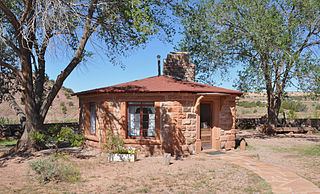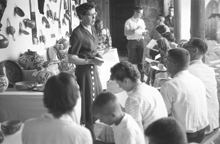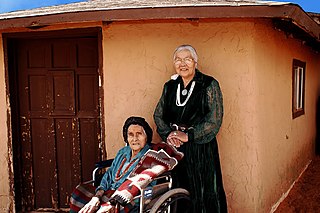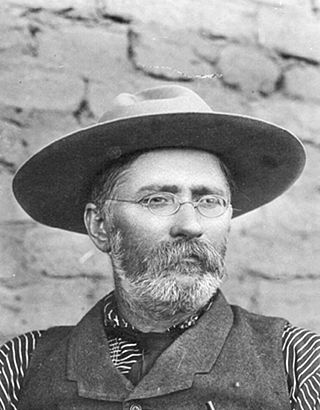Related Research Articles

The Hopi are a Native American ethnic group who primarily live on the Hopi Reservation in northeastern Arizona, United States. As of the 2010 census, there are 19,338 Hopi in the country. The Hopi Tribe is a sovereign nation within the United States and has government-to-government relations with the United States federal government. Particular villages retain autonomy under the Hopi Constitution and Bylaws. The Hopi language is one of 30 in the Uto-Aztecan language family. The majority of Hopi people are enrolled in the Hopi Tribe of Arizona but some are enrolled in the Colorado River Indian Tribes. The Hopi Reservation covers a land area of 2,531.773 sq mi (6,557.26 km2).

Coconino County is a county in the north-central part of the U.S. state of Arizona. Its population was 145,101 at the 2020 census. The county seat is Flagstaff. The county takes its name from Cohonino, a name applied to the Havasupai people. It is the second-largest county by area in the contiguous United States, behind San Bernardino County, California. It has 18,661 sq mi (48,300 km2), or 16.4% of Arizona's total area, and is larger than each of the nine smallest states in the U.S.

Ganado is a chapter of the Navajo Nation and census-designated place (CDP) in Apache County, Arizona, United States. The population was 1,210 at the 2010 census.

Tuba City is an unincorporated town in Coconino County, Arizona, on the Navajo Nation, United States. It is the second-largest community in Coconino County. The population of the census-designated place (CDP) was 8,611 at the 2010 census.

The Navajo Nation, also known as Navajoland, is a Native American reservation in the United States. It occupies portions of northeastern Arizona, northwestern New Mexico, and southeastern Utah; at roughly 17,544,500 acres, the Navajo Nation is the largest land area held by a Native American tribe in the U.S., exceeding ten U.S. states. In 2010, the reservation was home to 173,667 out of 332,129 Navajo tribal members; the remaining 158,462 tribal members lived outside the reservation, in urban areas, border towns, and elsewhere in the U.S.. The seat of government is located in Window Rock, Arizona.

The Dark Wind is the fifth crime fiction novel in the Joe Leaphorn / Jim Chee Navajo Tribal Police series by Tony Hillerman, published in 1982. It is the second of the novels to feature Officer Jim Chee.

The First Eagle is the thirteenth crime fiction novel in the Joe Leaphorn / Jim Chee Navajo Tribal Police series by Tony Hillerman, first published in 1998.
KNAU is a radio station broadcasting a classical music and news/talk and information format. Licensed to Flagstaff, Arizona, United States, KNAU and its sister stations serve the northern Arizona area. The station is currently owned by Northern Arizona University (NAU) and features programming from National Public Radio, Public Radio International, and American Public Media, among other content providers. NAU also owns KPUB, a station devoted to talk programming, and student-run low-power station KLJX-LP. KNAU's programming is heard on KNAA in Show Low and on five translators in northern Arizona, as well as online.

Diane Joyce Humetewa is a United States district judge of the United States District Court for the District of Arizona and was the United States Attorney for the District of Arizona, serving in that position from December 2007 to August 2009. Confirmed in 2014 as the first Native American woman and enrolled tribal member to serve as a federal judge, Humetewa, a Hopi, is one of six Native Americans in history to serve in this position. Humetewa is also a Professor of Practice at Arizona State University's Sandra Day O'Connor College of Law. Humetewa has served as counsel to the Senate Committee on Indian Affairs and to the Deputy Attorney General for the United States Department of Justice, as a member of the United States Sentencing Guideline Commission, Native American Advisory Committee, and as an Appellate Court Judge for the Hopi Tribe, of which she is an enrolled member.

Merril L.Sandoval was an American Navajo World War II veteran and a member of the Navajo Code Talkers, a group of United States Marines who transmitted important messages in their native Navajo language in order to stop the Japanese from intercepting sensitive material. Sandoval took part in every Marine landing in the Pacific Ocean theater of World War II from 1943 until 1945.

Mary-Russell Ferrell Colton was an American artist, author, educator, ethnographer, and curator. She is one of the principal founders of the Museum of Northern Arizona. She was a member of the Philadelphia Ten, exhibiting at the group's annual shows from 1926 to 1940. She was also a member of the National Association of Women Painters and Sculptors, the American Watercolor Society, and the American Federation of Arts. She is known for her advocacy of the arts, Native American rights, and women's rights. For her advocacy of Native American arts, she received a certificate of appreciation from the United States Department of the Interior, Indian Arts and Crafts Board in 1935. In 1982, she was inducted into the Arizona Women's Hall of Fame.

Katharine Bartlett (1907–2001) was an American physical anthropologist who worked from 1930 to 1952 as the first curator of the Museum of Northern Arizona, cataloging and organizing the museum's holdings, and then as the museum's librarian until 1974 and archivist until 1981. She participated in a survey of the Navajo Nation's reservation in the Little Colorado River basin and established the cataloging system used by the Glen Canyon Archaeological Project. She was a Fellow of the American Association for the Advancement of Science, a Fellow of the American Anthropological Association and a Fellow of the Society of American Archaeology, as well as the first Fellow of the MNA. Honored in an exhibit of the Smithsonian Institution in 1986 and a recipient of the 1991 Sharlot Hall Award for her contributions to Arizona history, she was posthumously inducted into the Arizona Women's Hall of Fame in 2008.

Polingaysi Qöyawayma, also known as Elizabeth Q. White, was a Hopi educator, writer, and potter.
Patty Talahongva is a Hopi journalist, documentary producer, and news executive. She was the first Native American anchor of a national news program in the United States and is involved in Native American youth and community development projects. A past president of the Native American Journalists Association, she was the recipient of their Medill Milestone Achievement Award in 2016. In 2019, she was hired as the news executive for the national television news program developed by Indian Country Today at Arizona State University.

Grace Henderson Nez was a Navajo weaver, known for her traditional designs. Her main styles were old designs from the 19th century and Ganado style. Some of her work was demonstrated at the Hubbell Trading Post, which is home to an archive of works from various Navajo weavers. Before her death in 2006, she was able to win two lifetime achievement awards for her work, including a National Heritage Fellowship from the National Endowment for the Arts.
Claudeen Bates Arthur was a Native American lawyer who was the first Navajo woman licensed as a lawyer in the United States and the first female Chief Justice of the Supreme Court of the Navajo Nation.
Tuba City Regional Health Care Corporation manages a hospital, 12 clinics, and mobile clinics in Tuba City, Arizona. The hospital and clinics serve primarily Native Americans in Arizona. The hospital was part of the Indian Health Service until 2002 when management was shifted to a corporation run by a local board of community members.

John Lorenzo Hubbell was a member of the Arizona State Senate. He was elected to serve in the 1st Arizona State Legislature from Apache County. He served in the Senate from March 1912 until March 1914. Hubbell was the long-time owner of the Hubbell Trading Post established in 1878 on the Navajo Reservation in Ganado, Arizona. The trading post is preserved as the Hubbell Trading Post National Historic Site.

Hattie Myrtle Greene Lockett was an American writer, rancher, and clubwoman. She was inducted into the Arizona Women's Hall of Fame in 1987.
References
- 1 2 3 4 5 6 7 8 9 10 11 12 13 14 15 16 17 18 Sweitzer, Paul (August 29, 1990). "Martha Blue". Arizona Daily Sun. Flagstaff, Arizona. p. 15. Retrieved June 5, 2020– via Newspapers.com.

- 1 2 Ryan, Michael D. (November 2000). "Arizona Trailblazers: Honoring 100 Women & Minority Lawyers". AZ Attorney. 37: 20.
- ↑ Nies, Judith (April 8, 2014). Unreal City: Las Vegas, Black Mesa, and the Fate of the West. PublicAffairs. ISBN 978-1-56858-487-4 . Retrieved June 6, 2020.
- ↑ Nies, Judith (October 15, 2002). Nine Women: Portraits from the American Radical Tradition. University of California Press. ISBN 978-0-520-22965-5 . Retrieved June 6, 2020.
- 1 2 3 4 5 6 7 8 9 10 11 12 Stevens, Jan (April 18, 1990). "Lawyer's book outlines ABCs of publishing". Arizona Daily Sun. Flagstaff, Arizona. p. 15. Retrieved June 5, 2020– via Newspapers.com.

- 1 2 3 4 5 "Flagstaff Pen Women To Sponsor Workshop". Arizona Daily Sun. Flagstaff, Arizona. May 19, 1983. p. 7. Retrieved June 5, 2020– via Newspapers.com.

- 1 2 3 4 5 6 "Martha Blue; lawyer, her own person first". Arizona Daily Sun. Flagstaff, Arizona. March 27, 1976. p. 83. Retrieved June 5, 2020– via Newspapers.com.

- 1 2 3 4 5 "Blue weaves intricacies of Hubbell's life into fascinating biography". Arizona Daily Sun. Flagstaff, Arizona. August 3, 2000. p. A4. Retrieved June 5, 2020– via Newspapers.com.

- 1 2 3 4 5 Anderson, Mike (April 16, 2006). "2006 Northern Arizona Book Festival Guests". Arizona Daily Sun. Flagstaff, Arizona. p. 21. Retrieved June 5, 2020– via Newspapers.com.

- 1 2 3 "Martha A. Manning". Arizona Daily Sun. Flagstaff, Arizona. August 31, 1993. p. 3. Retrieved June 5, 2020– via Newspapers.com.
